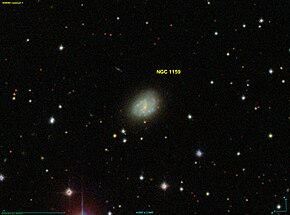This is an old revision of this page, as edited by Galaxybeing (talk | contribs) at 11:20, 10 December 2024 (Changed discovery and name of astronomer, added in another citation). The present address (URL) is a permanent link to this revision, which may differ significantly from the current revision.
Revision as of 11:20, 10 December 2024 by Galaxybeing (talk | contribs) (Changed discovery and name of astronomer, added in another citation)(diff) ← Previous revision | Latest revision (diff) | Newer revision → (diff) Galaxy in the constellation Eridanus| NGC 1159 | |
|---|---|
 | |
| Observation data (J2000 epoch) | |
| Constellation | Perseus |
| Right ascension | 02h 58m 06.6s |
| Declination | −15° 07′ 05″ |
| Redshift | 0.010885 |
| Apparent magnitude (V) | 14.8 |
| Characteristics | |
| Type | Sb (Spiral) |
| Apparent size (V) | 0.6′ × 0.3′ |
| Other designations | |
| PGC 11283, UGC 2467, CGCG 540-023 | |
NGC 1159 is a spiral galaxy located in the constellation Perseus. It was discovered by astronomer Edouard Stephan in December 2, 1883.
Description
The galaxy has a redshift of 0.008763, indicating it is moving away from Earth at a velocity of 2616 km/s. The galaxy's approximate distance from the Milky Way is 62.9 million light-years (19.3 megaparsecs).
The apparent magnitude of NGC 1159 is 14.2 in the blue band, and it has an angular size of 0.48 × 0.4 arcminutes. The galaxy's morphology classification is Sc, signifying a late-type spiral galaxy.
References
- "Revised NGC Data for NGC 1159". Spider SEDS Organization.
- "NGC 1159". Cseligman.
- "New General Catalog Objects: NGC 1150 - 1199". cseligman.com. Retrieved 2024-12-10.
- "NGC 1159 Overview". Go Astronomy.